Originating from the freshwater habitats of New Guinea and Indonesia, the Dwarf Neon Rainbowfish (Melanotaenia praecox) is a truly captivating species that has captivated fish enthusiasts around the globe in the vibrant realm of aquariums. As a member of the Melanotaeniidae family, this small yet exquisite fish, measuring a mere 2-3 inches in length, never fails to leave a lasting impression.
Table of Contents
The Dwarf Neon Rainbowfish’s striking appearance is one of the reasons why it has become a popular choice among aquarists. Its iridescent body is adorned with a mesmerizing array of colors, ranging from electric blue to vibrant red, making it a true jewel of the aquatic realm. In the market, this species is also known by various names, such as Praecox Rainbowfish and Dwarf Rainbowfish.
Interestingly, a research journal published in the Journal of Fish Biology shed light on the unique reproductive behavior of the Dwarf Neon Rainbowfish. The study revealed that males engage in elaborate courtship displays, flaring their fins and showcasing their vibrant colors to attract potential mates. This fascinating insight into their mating rituals has only added to the allure of this species.
When it comes to their habitat preferences, Dwarf Neon Rainbowfish are mid-dwellers, occupying the middle layers of the aquarium. They thrive in well-planted tanks with plenty of open swimming space, as they are active swimmers that enjoy exploring their surroundings. A temperature range of 72-82°F (22-28°C) and a pH level between 6.5 and 7.5 provide the ideal conditions for their well-being.
In terms of diet, Dwarf Neon Rainbowfish are omnivorous and can be easily satisfied with a variety of foods. They readily accept high-quality flake food, frozen or live brine shrimp, daphnia, and bloodworms. Providing them with a balanced diet ensures their vibrant colors remain at their best and promotes overall health.
One of the most appealing aspects of Dwarf Neon Rainbowfish is their peaceful temperament, making them excellent tank mates for other non-aggressive species. They thrive in groups of at least six individuals, as they are schooling fish that find comfort and security in the presence of their own kind. Some ideal tank mates include other small rainbowfish species, tetras, rasboras, and peaceful bottom-dwellers like corydoras catfish.
Did you know that the Dwarf Neon Rainbowfish has a rich history in the aquarium trade? They were first introduced to the hobby in the 1930s and have since become a staple in many community tanks around the world. Their popularity has only grown over the years, thanks to their stunning appearance and adaptability to various aquarium setups.
As we delve deeper into the world of Dwarf Neon Rainbowfish, it becomes clear that these tiny marvels are not only visually stunning but also full of surprises. With their fascinating behavior, peaceful nature, and adaptability, they have rightfully earned their place as a beloved species among aquarium enthusiasts.
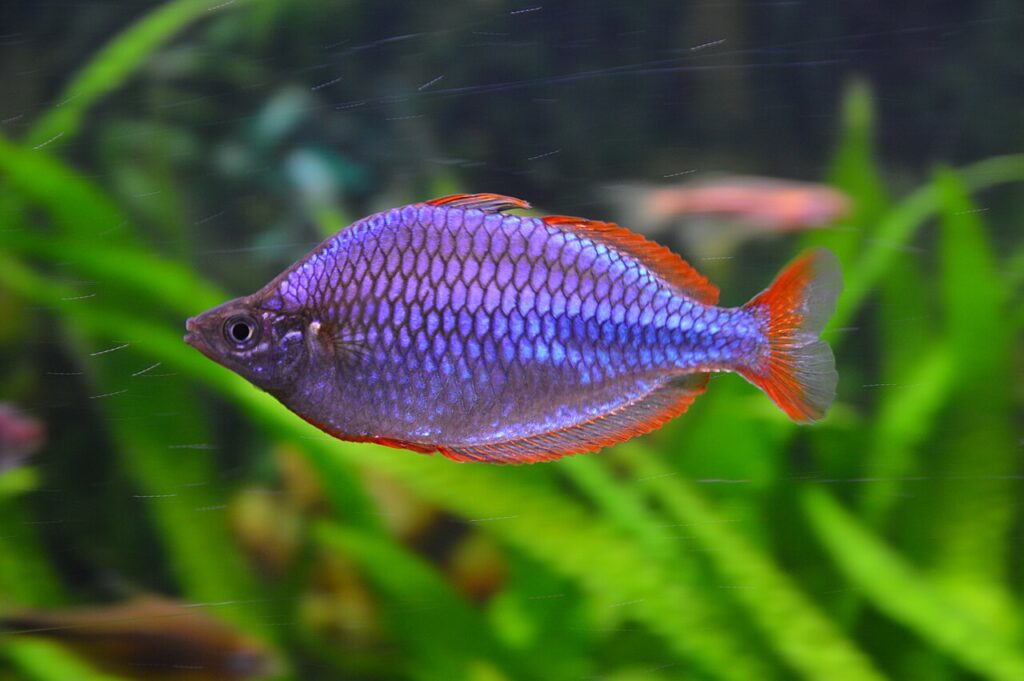
Key Information
The Dwarf Neon Rainbowfish (Melanotaenia praecox) is a stunning freshwater fish that captivates aquarium enthusiasts with its vibrant colors. Males display an iridescent blue body with red fins, while females have a more subdued silvery-blue coloration. The intense blue and red hues of the males intensify during breeding, creating a mesmerizing display in the aquarium.
| Family | Melanotaeniidae |
| Origin | New Guinea and Indonesia |
| Price | $5 to $10 per fish |
| Common Names | Dwarf Rainbowfish, Praecox Rainbowfish |
| Variants | None |
| Ideal Tank Size | 20 gallons or larger |
| Water Parameters | Temperature: 72-82°F (22-28°C), pH: 6.5-7.5, Hardness: 5-20 dGH |
| Lifespan | 3-5 years |
| Full Size | 2-3 inches (5-7.5 cm) |
| Natural Environment | Freshwater streams and rivers |
| Behavior | Peaceful, active, schooling |
| Habitat Preference | Mid-level swimmer, prefers well-planted tanks with open swimming areas |
| Aquarium Decoration | Plenty of live plants, driftwood, rocks |
| Ideal Tank Mates | Other peaceful fish, such as small rainbowfish, tetras, rasboras, and corydoras catfish |
| Fish to Avoid | Large, aggressive fish that may bully or eat them |
| Best Foods/Diet | Omnivorous; high-quality flake food, frozen or live brine shrimp, daphnia, and bloodworms |
| Disease | Susceptible to common freshwater fish diseases if water quality is poor |
| Sex-switch | No |
| Gender Differences | Males are more colorful and have larger fins than females |
| Care Level | Easy |
| Breeding Level | Moderate; spawning occurs in fine-leaved plants, and eggs hatch in about 7 days |
Ideal Tank Mates
For a thriving aquarium environment for Dwarf Neon Rainbowfish (Melanotaenia praecox), it’s essential to carefully assess the compatibility of tank mates based on water conditions, temperament, and habitat preferences. Given their peaceful demeanor and lively nature, Dwarf Neon Rainbowfish are an excellent addition to community tanks alongside other non-aggressive fish, as they value the company of their own species.
Compatible tank mates should be able to thrive in the same water conditions as Dwarf Neon Rainbowfish, which prefer temperatures between 72-82°F (22-28°C), a pH range of 6.5-7.5, and moderate water hardness. Additionally, tank mates should be similar in size to the Dwarf Neon Rainbowfish to avoid any potential bullying or predation.
Here are 15 ideal tank mates for Dwarf Neon Rainbowfish, along with explanations of why they are compatible:
1. Threadfin Rainbowfish (Iriatherina werneri)
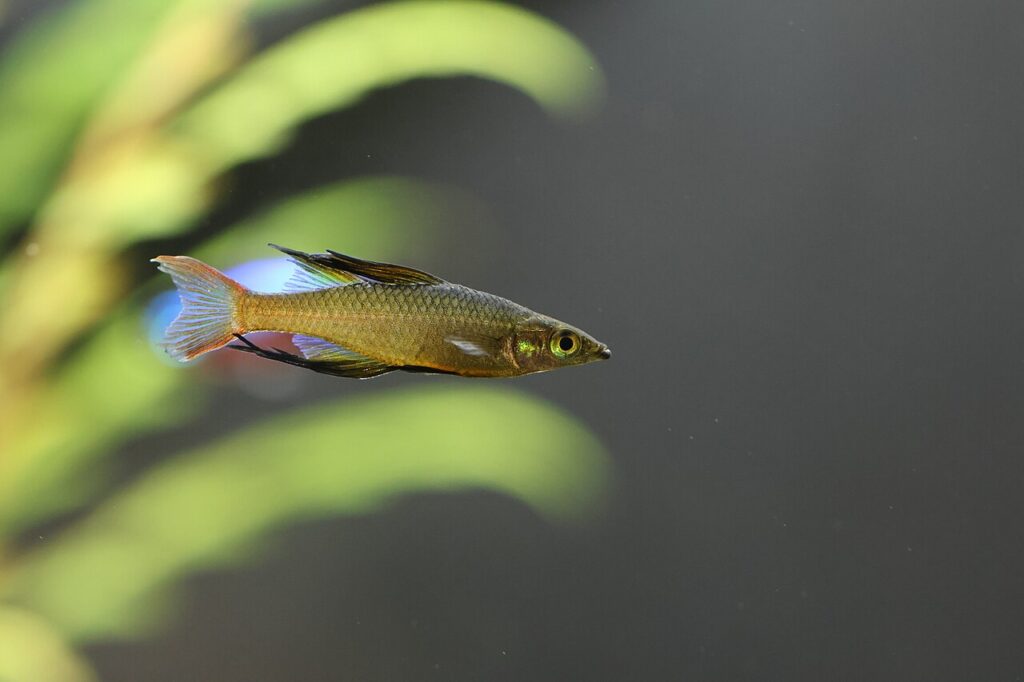
Threadfin Rainbowfish are a perfect match for Dwarf Neon Rainbowfish, as they share similar water requirements and exhibit a peaceful demeanor. These elegant fish feature long, flowing fins that add a unique visual appeal to the aquarium. Threadfin Rainbowfish occupy the upper levels of the tank, while Dwarf Neon Rainbowfish typically swim in the middle, creating a harmonious balance.
2. Pygmy Corydoras (Corydoras pygmaeus)
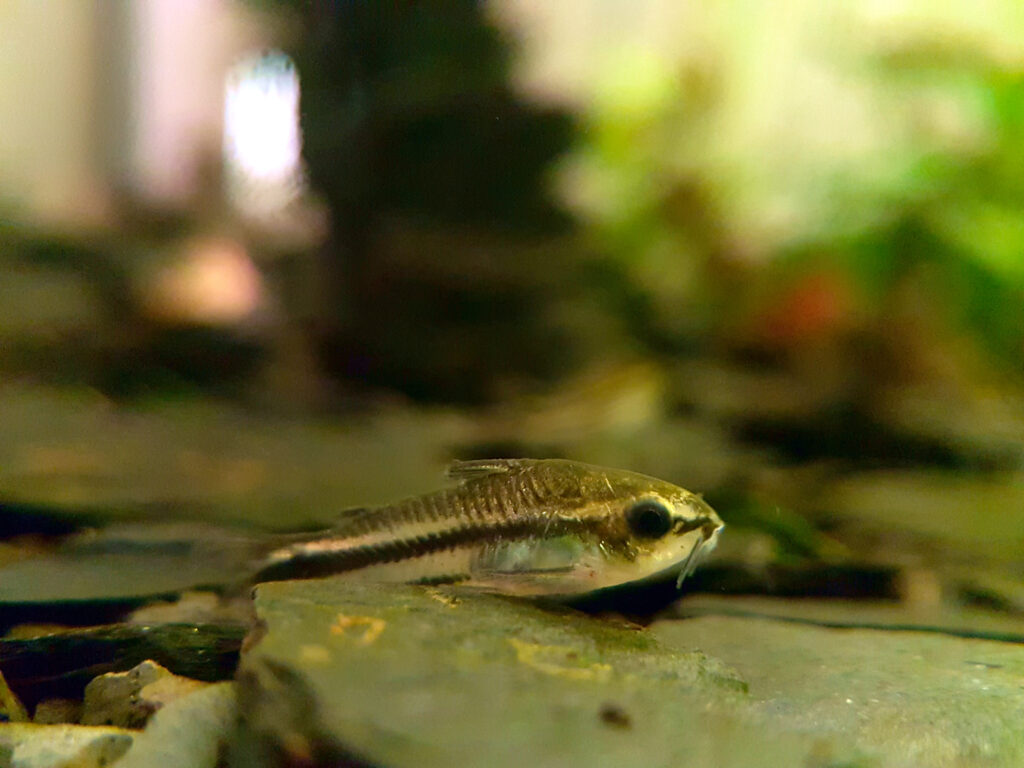
Pygmy Corydoras are tiny, peaceful bottom-dwellers that make excellent tank mates for Dwarf Neon Rainbowfish. These adorable catfish are active scavengers that help keep the substrate clean by consuming leftover food and debris. Their small size and peaceful nature ensure they won’t disturb the Dwarf Neon Rainbowfish, and their presence adds a delightful variety to the lower levels of the aquarium.
3. Lambchop Rasbora (Trigonostigma espei)
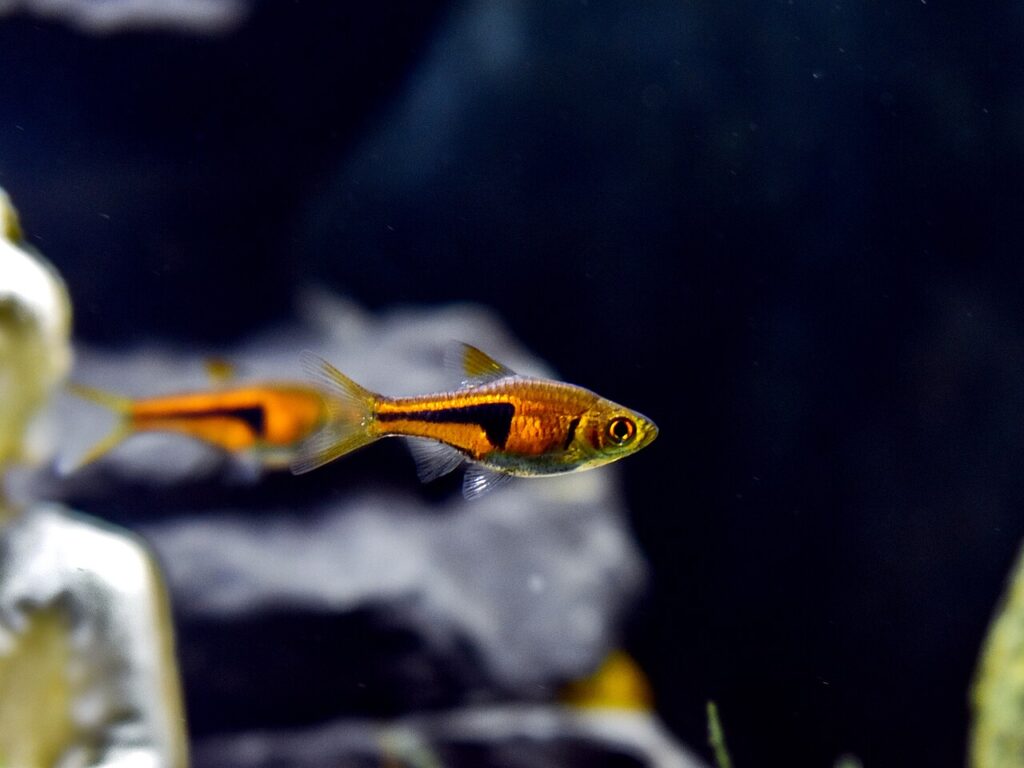
Lambchop Rasboras are a striking and peaceful schooling fish that complement Dwarf Neon Rainbowfish beautifully. These rasboras have a unique triangular shape and a vibrant orange coloration that adds a pop of color to the aquarium. Lambchop Rasboras occupy the middle to upper levels of the tank, swimming alongside the Dwarf Neon Rainbowfish without any territorial disputes.
4. Dwarf Pencilfish (Nannostomus marginatus)
Dwarf Pencilfish are slender, peaceful fish that make fantastic tank mates for Dwarf Neon Rainbowfish. These pencilfish have a distinctive horizontal stripe pattern and a gentle disposition. They prefer to school in groups and occupy the middle to lower levels of the aquarium, providing a visually appealing contrast to the Dwarf Neon Rainbowfish.
5. Chili Rasbora (Boraras brigittae)
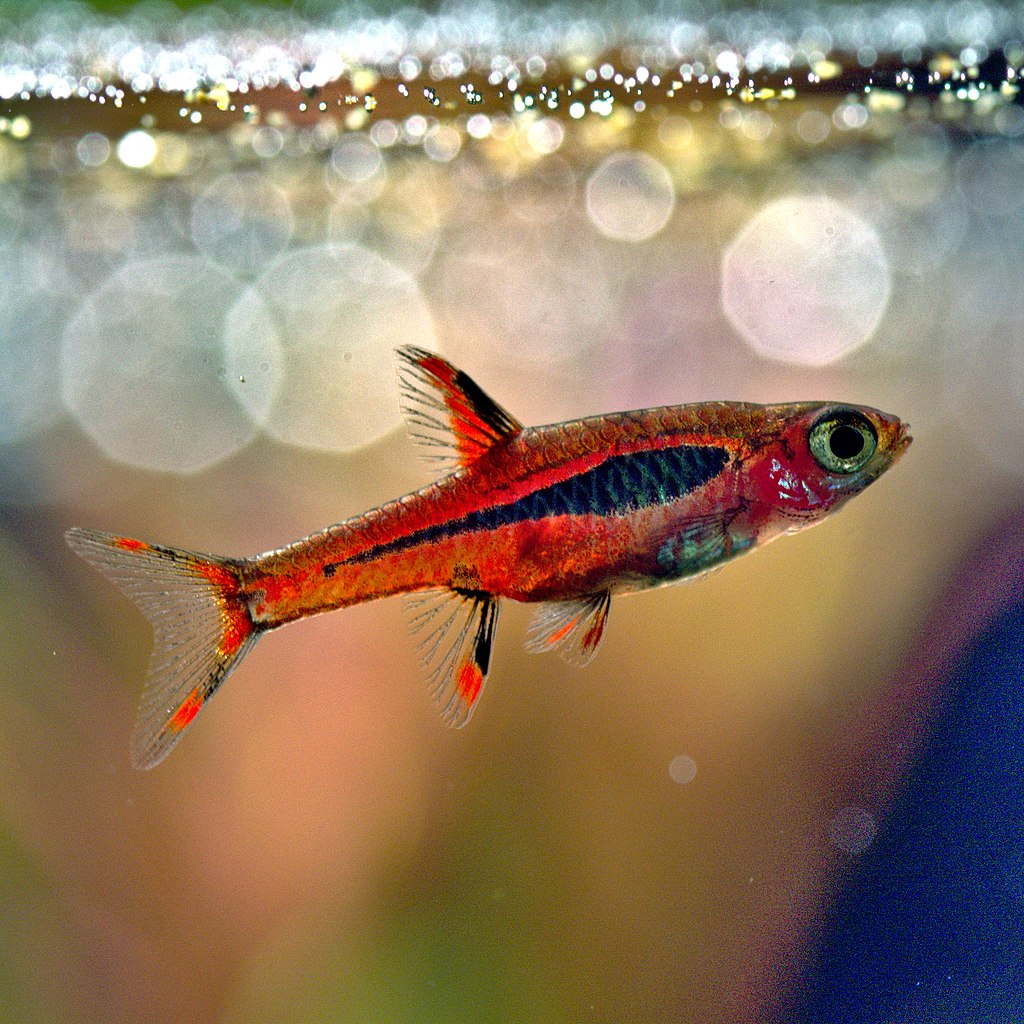
Chili Rasboras are tiny, vibrant fish that are well-suited for life alongside Dwarf Neon Rainbowfish. These rasboras have a striking red coloration and prefer to school in groups, creating a mesmerizing display in the aquarium. Chili Rasboras are peaceful and occupy the middle to upper levels of the tank, coexisting harmoniously with Dwarf Neon Rainbowfish.
6. Endler’s Livebearer (Poecilia wingei)
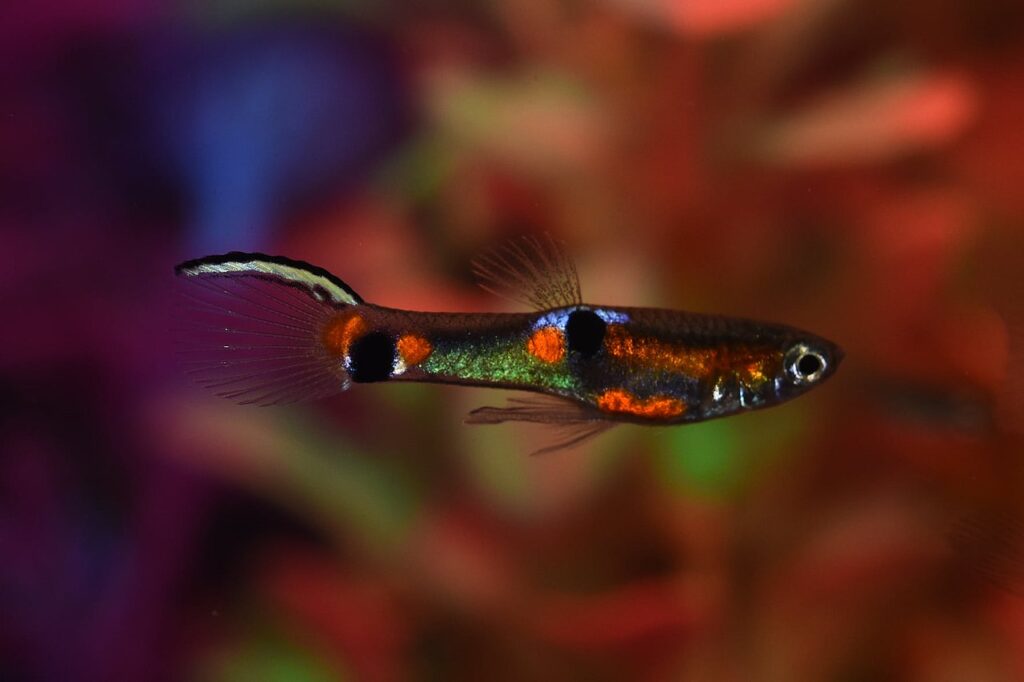
Endler’s Livebearers are small, colorful fish that make excellent tank mates for Dwarf Neon Rainbowfish. These livebearers come in a variety of colors and patterns, adding visual interest to the aquarium. Endler’s Livebearers are peaceful and prefer to swim in the middle to upper levels of the tank, making them compatible with the swimming habits of Dwarf Neon Rainbowfish.
7. Pygmy Hatchetfish (Carnegiella myersi)
Pygmy Hatchetfish are unique, peaceful fish that occupy the top level of the aquarium, making them an ideal companion for Dwarf Neon Rainbowfish. These hatchetfish have a distinct shape, with a flattened body and upturned mouth, allowing them to feed on small insects and food particles at the water’s surface. Pygmy Hatchetfish add an interesting dimension to the tank without interfering with the Dwarf Neon Rainbowfish.
8. Dwarf Rasbora (Boraras maculatus)
Dwarf Rasboras, also known as Spotted Rasboras, are tiny, peaceful fish that thrive in the company of Dwarf Neon Rainbowfish. These rasboras have a translucent body with a prominent black spot on their side, creating an eye-catching display. Dwarf Rasboras prefer to school in groups and occupy the middle levels of the aquarium, swimming alongside the Dwarf Neon Rainbowfish without any conflicts.
9. Mosquito Rasbora (Boraras merah)
Mosquito Rasboras are another small, peaceful schooling fish that make excellent tank mates for Dwarf Neon Rainbowfish. These rasboras have a reddish-orange coloration and a slender body, adding a vibrant touch to the aquarium. Mosquito Rasboras occupy the middle to upper levels of the tank and are known for their active swimming behavior, which complements the lively nature of Dwarf Neon Rainbowfish.
10. Dwarf Cory (Corydoras habrosus)
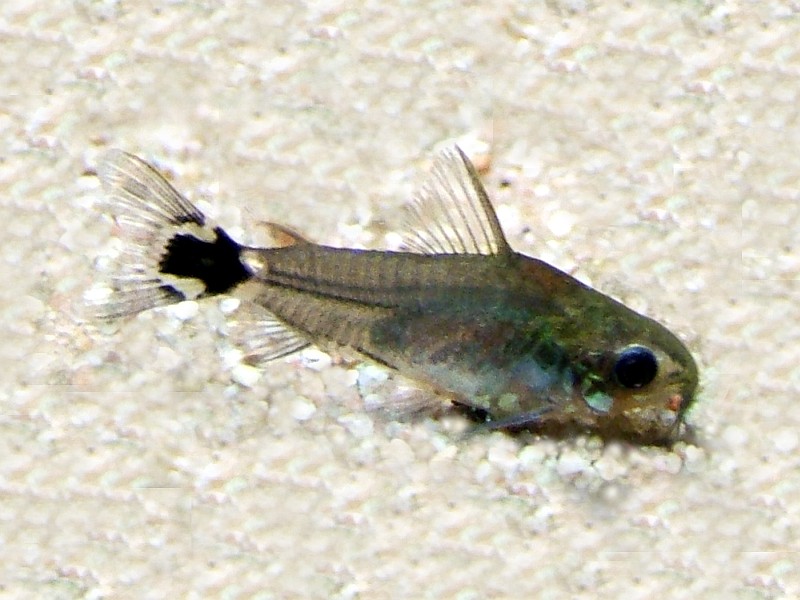
Dwarf Corys are small, peaceful bottom-dwellers that are compatible with Dwarf Neon Rainbowfish. These corys have a gentle disposition and are active scavengers, helping to maintain a clean substrate. Dwarf Corys prefer to be kept in groups and add a delightful presence to the lower levels of the aquarium without disturbing the Dwarf Neon Rainbowfish.
11. Neon Green Rasbora (Microdevario kubotai)
Neon Green Rasboras are stunning, peaceful fish that make fantastic tank mates for Dwarf Neon Rainbowfish. These rasboras have a bright green iridescent coloration that shimmers under aquarium lighting. Neon Green Rasboras are active swimmers and prefer to school in groups, occupying the middle to upper levels of the tank and creating a visually striking display alongside the Dwarf Neon Rainbowfish.
12. Pygmy Rainbowfish (Melanotaenia pygmaea)
Pygmy Rainbowfish are a perfect match for Dwarf Neon Rainbowfish, as they belong to the same genus and share similar water requirements and behavior. These rainbowfish are slightly smaller than their Dwarf Neon counterparts and exhibit a beautiful iridescent coloration. Pygmy Rainbowfish school together and occupy the middle levels of the aquarium, creating a stunning display of colors when combined with Dwarf Neon Rainbowfish.
13. Green Neon Tetra (Paracheirodon simulans)
Green Neon Tetras are peaceful, schooling fish that make excellent tank mates for Dwarf Neon Rainbowfish. These tetras have a striking iridescent green stripe along their body, which complements the vibrant colors of the Dwarf Neon Rainbowfish. Green Neon Tetras occupy the middle levels of the aquarium and are active swimmers, adding a lively presence to the tank.
14. Sparkling Gourami (Trichopsis pumila)
Sparkling Gouramis are small, peaceful labyrinth fish that can coexist harmoniously with Dwarf Neon Rainbowfish. These gouramis have a unique appearance, with iridescent spots on their body that sparkle under aquarium lighting. Sparkling Gouramis prefer to inhabit the middle to upper levels of the tank and are known for their gentle demeanor, making them a perfect addition to a community tank with Dwarf Neon Rainbowfish.
15. Celestial Pearl Danio (Danio margaritatus)
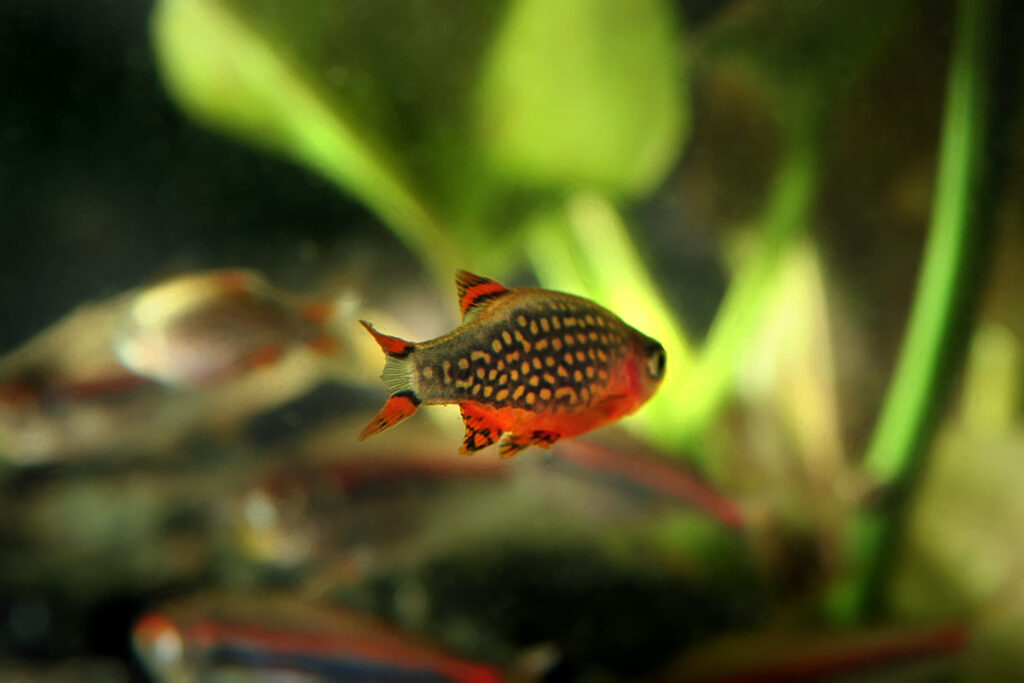
Celestial Pearl Danios, also known as Galaxy Rasboras, are small, peaceful fish that thrive in the company of Dwarf Neon Rainbowfish. These danios have a striking appearance, with a pearlescent body adorned with small, celestial-like spots. Celestial Pearl Danios are active swimmers and prefer to school in groups, occupying the middle levels of the aquarium and adding a captivating visual element to the tank.
FAQs
How many Dwarf Neon Rainbowfish should I keep together?
Dwarf Neon Rainbowfish are schooling fish and thrive in groups of at least six individuals. Keeping them in larger numbers helps reduce stress and promotes natural behavior, such as schooling and displaying vibrant colors.
Can Dwarf Neon Rainbowfish be kept in a planted aquarium?
Yes, Dwarf Neon Rainbowfish are an excellent choice for planted aquariums. They appreciate the natural environment provided by live plants, which offer hiding spots and help maintain good water quality. Ensure that the plants are well-established and not too delicate, as these active fish may disturb them while swimming.
Are Dwarf Neon Rainbowfish jumpers?
Yes, Dwarf Neon Rainbowfish are known to be jumpers, especially when startled or in an aquarium with an open top. To prevent them from jumping out, make sure your tank has a tight-fitting lid or cover.
How often should I feed my Dwarf Neon Rainbowfish?
Feed your Dwarf Neon Rainbowfish small amounts of food two to three times a day. Offer a variety of high-quality flake food, frozen, or live foods, such as brine shrimp, daphnia, and bloodworms. Avoid overfeeding, as this can lead to poor water quality and health issues.
Do Dwarf Neon Rainbowfish prefer a current in the aquarium?
In their natural habitat, Dwarf Neon Rainbowfish are found in streams and rivers with moderate water flow. While they don’t require a strong current in the aquarium, providing some water movement through a filter outlet or an air stone can help mimic their natural environment and keep them active.
Can Dwarf Neon Rainbowfish be kept with shrimp?
Yes, Dwarf Neon Rainbowfish can be kept with peaceful shrimp species, such as Cherry Shrimp (Neocaridina davidi) or Amano Shrimp (Caridina multidentata). However, keep in mind that very small or baby shrimp may be seen as food by the rainbowfish.
How can I tell the difference between male and female Dwarf Neon Rainbowfish?
Male Dwarf Neon Rainbowfish are typically more colorful than females, displaying vibrant blue bodies and red fins. Males also have larger fins, particularly the dorsal and anal fins. Females, on the other hand, have a more subdued silvery-blue coloration and smaller fins.
Do Dwarf Neon Rainbowfish need a heater in the aquarium?
Yes, Dwarf Neon Rainbowfish require a stable water temperature between 72-82°F (22-28°C). Unless you live in a particularly warm climate, it’s best to use an aquarium heater to maintain the appropriate temperature range consistently.
How often should I perform water changes for my Dwarf Neon Rainbowfish tank?
Perform weekly water changes of about 10-20% of the tank volume to maintain good water quality. Use a gravel vacuum to remove debris and waste from the substrate during water changes. Be sure to treat the new water with a suitable water conditioner to remove harmful chlorine and chloramines before adding it to the tank.